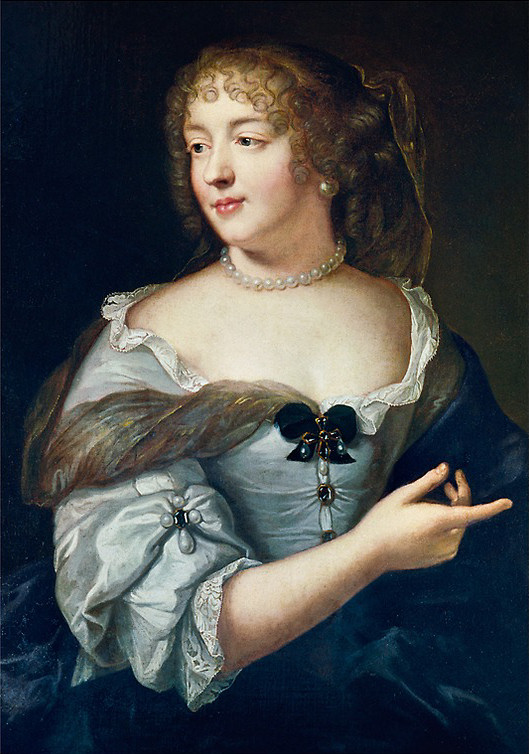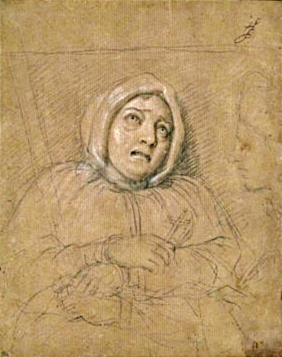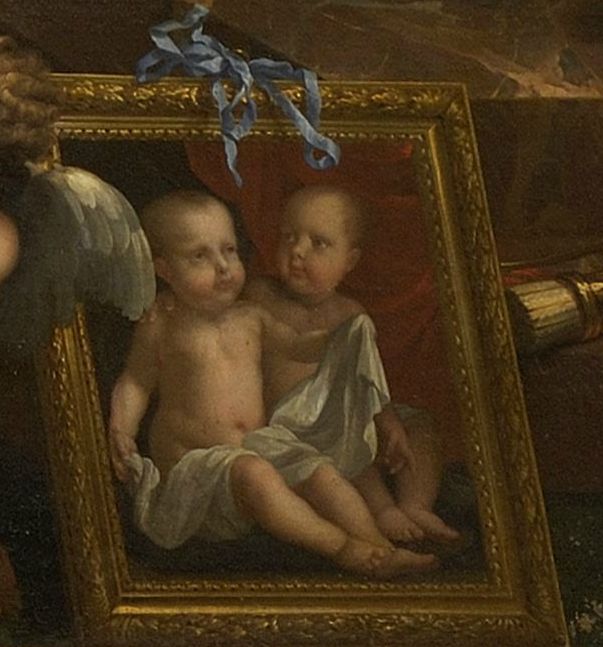Marie de Rabutin-Chantal, Marquise de Sévigné
When it comes to anecdotes or gossip from the court of Louis XIV, the name Madame de Sévigné shows up plenty. Marie de Rabutin-Chantal, born on February 5 in 1626, left us plenty material in form of letters to transport us back into the time of the Sun King.

Marie was born in the heart of Paris in the Hôtel Coulanges, now the fashionable Place des Vosges area, into a old and distinguished family from Burgundy. Her father, Celse Bénigne de Rabutin, Baron de Chantal, was killed during the attack on the Isle of Rhé in July 1627, as Marie was only a bit over a year old. Her mother, Marie de Coulanges, died as Marie was seven years old. She was given into the care of her maternal grandparents and upon the death of her grandfather, Philippe de Coulanges, in 1636 into the care of her uncle Christophe de Coulanges, Abbé de Livry.
The Abbé de Livry ensured that Marie received a good education worthy of a noble woman. She appreciated much as an adult and called him in her correspondence le Bien Bon. She learned to read and write, Italian and Spanish, how to dance and ride, how to run a Household, and made contacts with people of the high society, like the famous salon hostess Catherine de Vivonne, Marquise de Rambouillet. Before she was given into the care of her maternal uncle, her paternal aunt and uncle tried to gain custody of her. Orphaned so young, Marie was the sole heir of her parents and their wealth, thus her paternal relations took an interest in her. They tried to lure her to come to Burgundy, where she might feel the desire to enter a convent, and give all her money to the relatives, or perhaps fancy to marry one of the sons of her paternal aunt and uncle. Luckily for Marie, her still living maternal grandmother intervened and arranged for Marie to remain in Paris in the care of Christophe de Coulanges and his wife Marie d’Ormesson, a member of the noblesse de robe.
Although orphaned early and given into the care of various people, Marie’s childhood was a happy one. Aged eighteen, and in possession of a 300.000 francs dowry, Marie married Henri de Sévigné, a member of a Breton noble family attached to the Gondi family and Cardinal de Retz. The marriage took place on 4 August in 1644 and according to Roger Duchêne, a French biographer specialising in the letters of Madame de Sévigné, the groom went by the title Marquis de Sévigné, but actually had no real title of nobility. Nevertheless, Marie became the Marquise Sévigné.
The newlyweds remained in Paris for a while and lived an extravagant spendthrift life. Their first child, a daughter named Françoise, was born on October 10 in 1646 and a son, named Charles follow on March 12 in 1648. Having produced a healthy heir, Marie had no longing to share the bed of her husband anymore and allowed him to be merry with his mistress Madame de Gondran. Three years later, Marie’s husband died and left her a widow at the age of twenty-four. The death of the Marquis was a bit of a scandalous one. He quarrelled with the Chevalier d’Albret about Madame de Gondran and it led to a duel in which the Marquis was fatally wounded. He died two days after the duel on 4 February 1651.

The Marquise never married again and devoted her time to her two children. For support, she turned to the Gondi family, but that turned out to be a mistake. The Gondis got themselves involved into the Fronde. Cardinal de Retz was anti Cardinal Mazarin and the plotting of Retz reflected on the Marquise. Marie-Madeleine Pioche de la Vergne aka Madame de Lafayette, who wrote the famous La Princesse de Clèves, had become Madame de Sévigné’s friend during this time and shared her fate. (Madame de Lafayette’s stepfather was an uncle of Madame de Sévigné’s husband.) Marie relocated herself to Les Rochers and payed frequent trips to Paris, where she was often seen in the salon of Nicolas Fouquet, until she decided to remain in Paris in 1653. She swiftly collected quite a few noble admirers, but did not plan to marry again. As rich and young widow, she could lead a self-directed life with many freedoms. A husband would only be a hassle. In the Parisian salons, she quickly gained a reputation as pleasant and smart conversation partner and made a bit of an impression on a other grand dame, Madeleine de Scudéry. Mademoiselle de Scudéry lived and independent life as celebrated writer and painted a very flattering picture of Marie in her novel Clélie.
All the while, Marie noted whatever went on around her in letters, some of them addressed to her memoirist cousin Roger de Bussy-Rabutin. The latter had a bit of a thing for her and tried to get money from her in 1658, which led to a temporary break. Madame de Sévigné was rather skilled with words and her letters always a highlight to read. Many of them were shown around to others, because they were so very amusing and interesting. It made her a much desired pen-pal. Her friend Nicolas Fouquet received quite a few letters and upon his arrest in 1661, Marie feared for the worst. She thought the fact that she wrote in her usual sassy way with him, might get her into a bit of trouble with the Crown. Said letters indeed found their way to Louis XIV and he read them… but instead of being branded as Fouquet friend by the King, Louis found her letters rather amusing and allowed her to appear at court. Her daughter Françoise was even allowed to dance in several ballets with the King and both mother and daughter were present during the Pleasures of the Enchanted Island. Rumour had it, Louis was ogling Françoise…
 In 1669, Françoise married François Adhémar de Monteil, Comte de Grignan, a nobleman from Provence. It was his third marriage. The couple planned to live in Paris, but the Comte made was lieutenant governor of Provence and Marie had to say adieu to her daughter. The beginning of her famous correspondence in form of letters, that lasted to her demise.
In 1669, Françoise married François Adhémar de Monteil, Comte de Grignan, a nobleman from Provence. It was his third marriage. The couple planned to live in Paris, but the Comte made was lieutenant governor of Provence and Marie had to say adieu to her daughter. The beginning of her famous correspondence in form of letters, that lasted to her demise.
“I receive your letters in the same way in which you received my ring. I am in tears while I read them. My heart seems ready to burst. Bystanders would think that you had treated me ill in your letters, or were sick, or that some accident had happened to you; whereas every thing is the reverse. You love me, my dear child; you love me, and you tell me so in a manner that makes my tears flow in torrents. You continue your journey without any disagreeable accident. To know this, is the thing I could the most desire; and yet am I in this deplorable condition ! And do you then take a pleasure in thinking of me ? in talking of me ? and have more satisfaction in writing your sentiments to me than in telling them ? In whatever way they come, they meet with a reception, the warmth of which can only be known to those who love as I do. In expressing yourself thus, you make me feel the greatest tenderness for you that is possible to be felt; and if you think of me, be assured that I, on my side, am continually thinking of you. Mine is what the devotees call an habitual thought; it is what we ought to have for the Divine Being, were we to do our duty. Nothing is capable of diverting me from it. I see your carriage continually driving on, never, never to come nearer to me; I fancy myself on the road, and am always in apprehensions of the carriage over- turning. I am almost distracted at the violent rains we have had the last three days, and am frightened to death at the thoughts of the Rhone. I have at this instant a map before me; I know every place you sleep at. Tonight you are at Nevers, Sunday you will be at Lyons, where you will receive this letter. I could only write to you at Moulins by Madame de Gueneguad. I have had but two letters from you; perhaps a third is on the road; they are my only comfort. I ask for no other. I am utterly incapable of seeing much company at a time; I may recover the feeling hereafter, but it is out of the question now. The Duchesses of Verneciel and Arpajon have used all their endeavors to divert me, for which I am much obliged to them. Never, surely, were there better people than in this country. I was all the day on Saturday at Madame de Villars, talking of you, and weeping; she takes a great share in my sorrow. Yesterday I heard Monsieur d’Agen preach, and was at Madame de Puisieux and Madame du Pui-du-Fou’s, who both send you a thousand remembrances. This evening I shall sup tete-cirtte in the Fauxbourgs. These are my carnivals. I have a mass said for you every day. This is no superstitious devotion. I have seen Adhemar but for a moment; I am going to write to him and thank him for his bed, for which I am more obliged to him even than you are. If you would give me real pleasure, take care of your health, sleep in that little snug bed, eat broth, and exert that courage which I want. Continue to write to me. The friendships you left behind you here are all increased, and I should never have done with compliments. If I were to tell you how much every one is concerned about your health.” Paris, Monday, February 9, 1671.
Not many of Madame de Sévigné’s letters from the 1640’s to the 1660’s have survived. Among those that have survived, is a series of letters addressed to a exiled Fouquet friend, in which she keeps him informed of the happenings regarding Fouquet’s trial. (The judge was a certain Olivier d’Ormesson, brother of her aunt Marie d’Ormesson.)
By the year 1673, Marie’s letters were shown around so often and even reprinted, that she had to adapt her writing style. They were no longer private letters, but a sort of public document. This also included those she wrote to her daughter, two or three each week, unless Marie was in Aix to visit her daughter or her daughter in Paris to visit her. The letters to her daughter have almost completely survived and count 764. In them she writes about everything that happens around her, including court, her health, like her serious illness of 1676, she writes of the trial of Madame de Brinvilliers, about moving into the Hôtel Carnavalet, the grief she felt as her friends La Rochefoucauld, Roger de Bussy-Rabutin and Madame de La Fayette died. She writes of the preparations for her son’s wedding in 1684, after which she divided her fortune among her children and only kept little for herself, and various amusing descriptions of court ceremonies. Covering a period of nearly thirty years.
Marie de Rabutin-Chantal caught a fever, maybe influenza or pneumonia, in 1696 and died on April 17 in Grignan.
We are never satisfied to have done well, and in endeavouring to do better, we do much worse.



